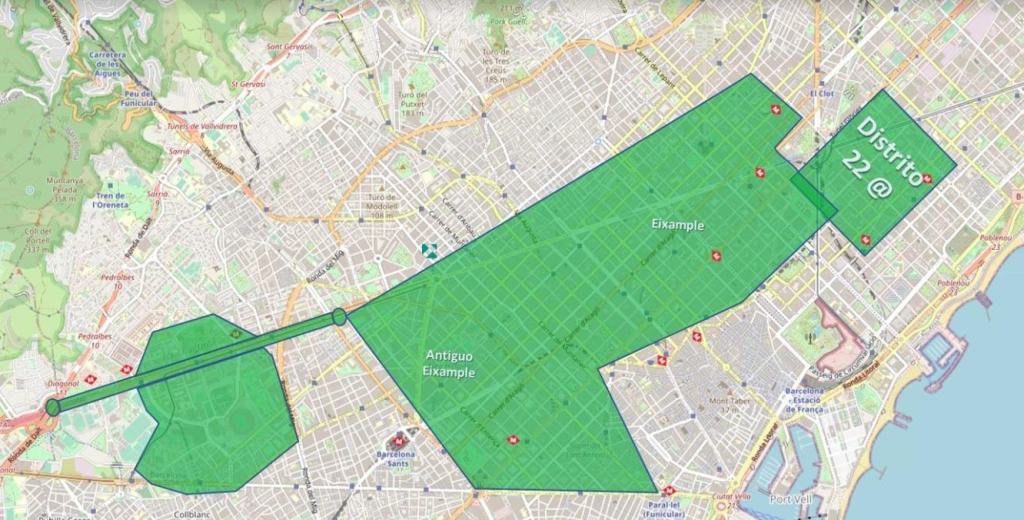Based on the information provided by the Institute of Regional and Metropolitan Studies of Barcelona, there has been a significant increase in the daily use of bikes and e-scooters in the city between 2019 and 2021. Specifically, the daily use of bikes increased by 34%, while e-scooters saw a staggering increase of 123%, making up 1/3 of the total flow on cycle lanes and reaching a 81,184 annual average daily traffic.
Given the growing number of users and the fact that Barcelona does not allow the operation of shared scooters, the RideSafeUM pilot has been a great opportunity to focus on the relationship between the authority and private users. The initial test area comprised the 22@ district and part of the Avinguda Diagonal, but it was later extended to incorporate part of the Eixample district and the university area. Micromobility regulations in Barcelona differentiate between bicycles and e-scooters for each type of infrastructure, and the RideSafeUM system has been adapted to the needs of the city.

As shared scooters are not permitted in the city, one of the challenges of this test was engaging with private users who may have initially only seen the app as a means for the council to gather circulation data but not necessarily as a tool that benefits them. Additionally, because there are no shared electric scooter services in the city, the RideSafeUM pilot in Barcelona has been addressed to users who own their own private micromobility vehicle. As a result, all participants of the pilot test received a phone support to be able to use the app from their vehicle, as well as RideSafeUM merchandising material in a “Welcome Pack”.
To attract users, the partners involved in the Barcelona pilot test have undertaken various dissemination efforts, including approaching close contacts of partner organizations who were interested in the solution, launching digital campaigns via LinkedIn and Google to redirect potential users to the RideSafeUM website designed for the pilot test, and using social media actions, participation in events and conferences, digital videos and printed materials, and an advertising campaign through the project’s website and Google. These efforts resulted in a user base that is higher than originally expected.
Ultimately, in order to evaluate the impact of the pilot we were able to obtain data from the developed dashboard , user surveys and finally, the direct feedback from the City Council. One of the main discovered challenges was related to battery consumption, as users reported a significant drop of battery while the app was in use. Considering this fact, the workplan for the second year of the project will include the optimisation of the computer vision process since, from an application point of view, the computer vision module is the technology that has the greatest impact on battery consumption.
Following up on the computer vision feature, the designed algorithm was evidenced to be able to recognize lanes in real time through the phone or an external camera, allowing the app to match specific regulations for cycling or riding on each type of lane.
An important feature of this app is the capability to detect accidents. While the sample of users did not enable pilot tests to provide a representative sample for a full evaluation of this functionality, preliminary results suggest that the accident detection module provides the best desired results, with the exception of a few exceptional cases where false positives were reported . A task will be included in 2023 workplan to keep optimising this “black box” function, to make sure the viability of the commercial strategy is strong in terms of this RideSafeUM key functionality.

Improvements and additional tests are required to be implemented during 2023 at accident detection and battery consumption levels, however these are for the purposes of achieving high competitiveness of the product in the micromobility market and do not imply the RideSafeUM technology has not been successfully developed during 2022 and implemented during the pilot tests.
In conclusion, the RideSafeUM pilot in Barcelona has been successful in adapting to the city’s micromobility regulations and engaging private users to utilize the app. The pilot test received a higher user base than expected despite the difficulties of dealing with private owners of e-scooters and bikes, and data was collected through various sources to improve the app during 2023.
Challenges such as phone battery consumption and concerns regarding GDPR have been identified and will be addressed in the 2023 workplan, including more information to explain how GDPR has been covered since the beginning of the project. Additionally, the app’s accident detection function will be optimized to ensure the viability of the commercial strategy.





